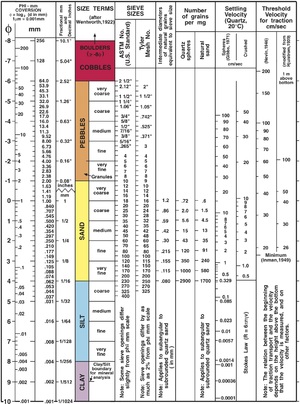
Grain size
This article includes a list of general references, but it lacks sufficient corresponding inline citations. (July 2011) |
| Granulometry | |
|---|---|
 | |
| Basic concepts | |
| Particle size, Grain size, Size distribution, Morphology | |
| Methods and techniques | |
| Mesh scale, Optical granulometry, Sieve analysis, Soil gradation | |
Related concepts | |
| Granulation, Granular material, Mineral dust, Pattern recognition, Dynamic light scattering | |


Grain size (or particle size) is the diameter of individual grains of sediment, or the lithified particles in clastic rocks. The term may also be applied to other granular materials. This is different from the crystallite size, which refers to the size of a single crystal inside a particle or grain. A single grain can be composed of several crystals. Granular material can range from very small colloidal particles, through clay, silt, sand, gravel, and cobbles, to boulders.

Krumbein phi scale
Size ranges define limits of classes that are given names in the Wentworth scale (or Udden–Wentworth scale named after geologists Chester K. Wentworth and Johan A. Udden) used in the United States. The Krumbein phi (φ) scale, a modification of the Wentworth scale created by W. C. Krumbein[1] in 1934, is a logarithmic scale computed by the equation

where

- is the Krumbein phi scale,
- is the diameter of the particle or grain in millimeters (Krumbein and Monk's equation)[2] and
- is a reference diameter, equal to 1 mm (to make the equation dimensionally consistent).
This equation can be rearranged to find diameter using φ:

| φ scale | Size range (metric) |
Size range (approx. inches) |
Aggregate name (Wentworth class) |
Other names |
|---|---|---|---|---|
| <−8 | >256 mm | >10.1 in | Boulder | |
| −6 to −8 | 64–256 mm | 2.5–10.1 in | Cobble | |
| −5 to −6 | 32–64 mm | 1.26–2.5 in | Very coarse gravel | Pebble |
| −4 to −5 | 16–32 mm | 0.63–1.26 in | Coarse gravel | Pebble |
| −3 to −4 | 8–16 mm | 0.31–0.63 in | Medium gravel | Pebble |
| −2 to −3 | 4–8 mm | 0.157–0.31 in | Fine gravel | Pebble |
| −1 to −2 | 2–4 mm | 0.079–0.157 in | Very fine gravel | Granule |
| 0 to −1 | 1–2 mm | 0.039–0.079 in | Very coarse sand | |
| 1 to 0 | 0.5–1 mm | 0.020–0.039 in | Coarse sand | |
| 2 to 1 | 0.25–0.5 mm | 0.010–0.020 in | Medium sand | |
| 3 to 2 | 125–250 μm | 0.0049–0.010 in | Fine sand | |
| 4 to 3 | 62.5–125 μm | 0.0025–0.0049 in | Very fine sand | |
| 8 to 4 | 3.9–62.5 μm | 0.00015–0.0025 in | Silt | Mud |
| 10 to 8 | 0.98–3.9 μm | 3.8×10−5–0.00015 in | Clay | Mud |
| 20 to 10 | 0.95–977 nm | 3.8×10−8–3.8×10−5 in | Colloid | Mud |
In some schemes, gravel is anything larger than sand (comprising granule, pebble, cobble, and boulder in the table above).

International scale
ISO 14688-1:2017, establishes the basic principles for identifying and classifying soils based on those material and mass characteristics most commonly used for soils for engineering purposes. ISO 14688-1 applies to natural soils in situ, similar man-made materials in situ and soils redeposited by people.[3]

| Name | Size range (mm) | Size range (approx. in) | |||
|---|---|---|---|---|---|
| Very coarse soil | Large boulder | lBo | >630 | >24.8031 | |
| Boulder | Bo | 200–630 | 7.8740–24.803 | ||
| Cobble | Co | 63–200 | 2.4803–7.8740 | ||
| Coarse soil | Gravel | Coarse gravel | cGr | 20–63 | 0.78740–2.4803 |
| Medium gravel | mGr | 6.3–20 | 0.24803–0.78740 | ||
| Fine gravel | fGr | 2.0–6.3 | 0.078740–0.24803 | ||
| Sand | Coarse sand | cSa | 0.63–2.0 | 0.024803–0.078740 | |
| Medium sand | mSa | 0.2–0.63 | 0.0078740–0.024803 | ||
| Fine sand | fSa | 0.063–0.2 | 0.0024803–0.0078740 | ||
| Fine soil | Silt | Coarse silt | cSi | 0.02–0.063 | 0.00078740–0.0024803 |
| Medium silt | mSi | 0.0063–0.02 | 0.00024803–0.00078740 | ||
| Fine silt | fSi | 0.002–0.0063 | 0.000078740–0.00024803 | ||
| Clay | Cl | ≤0.002 | ≤0.000078740 | ||
Sorting
An accumulation of sediment can also be characterized by the grain size distribution. A sediment deposit can undergo sorting when a particle size range is removed by an agency such as a river or the wind. The sorting can be quantified using the Inclusive Graphic Standard Deviation:[4]

where

- is the Inclusive Graphic Standard Deviation in phi units
- is the 84th percentile of the grain size distribution in phi units, etc.
The result of this can be described using the following terms:

| Diameter (phi units) | Description |
|---|---|
| < 0.35 | very well sorted |
| 0.35 < < 0.50 | well sorted |
| 0.50 < < 1.00 | moderately sorted |
| 1.00 < < 2.00 | poorly sorted |
| 2.00 < < 4.00 | very poorly sorted |
| 4.00 < | extremely poorly sorted |
See also
- Deposition (geology)
- Feret diameter
- Martin diameter
- Orders of magnitude (volume)
- Soil texture
- Substrate (biology)
- Unified Soil Classification System (USCS)
References
- ^ Krumbein, W. C. (1934). "Size frequency distributions of sediments". Journal of Sedimentary Petrology. 2 (4). doi:10.1306/D4268EB9-2B26-11D7-8648000102C1865D.
- ^ PetroWiki: Estimating permeability based on grain size
- ^ "ISO 14688-1:2017 – Geotechnical investigation and testing – Identification and classification of soil – Part 1: Identification and description". International Organization for Standardization (ISO).
- ^ Folk, Robert L.; Ward, William C. (1957). "Brazos River bar: a study in the significance of grain-size parameters" (PDF). Journal of Sedimentary Petrology. 27 (1): 3–26. Bibcode:1957JSedR..27....3F. doi:10.1306/74d70646-2b21-11d7-8648000102c1865d. Archived from the original (PDF) on 12 May 2014. Retrieved 11 May 2014.
External links
- R D Dean & R A Dalrymple, Coastal Processes with Engineering Applications (Cambridge University Press, 2002)
- W C Krumbein & L L Sloss, Stratigraphy and Sedimentation, 2nd edition (Freeman, San Francisco, 1963).
- Udden, J. A. (1914). "Mechanical composition of clastic sediments". Geological Society of America Bulletin. 25 (1): 655–744. Bibcode:1914GSAB...25..655U. doi:10.1130/GSAB-25-655.
- Wentworth, C. K. (1922). "A Scale of Grade and Class Terms for Clastic Sediments". The Journal of Geology. 30 (5): 377–392. Bibcode:1922JG.....30..377W. doi:10.1086/622910. JSTOR 30063207. S2CID 128682870.
See what we do next...
OR
By submitting your email or phone number, you're giving mschf permission to send you email and/or recurring marketing texts. Data rates may apply. Text stop to cancel, help for help.
Success: You're subscribed now !










